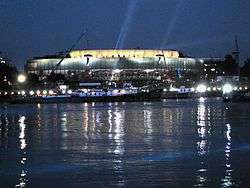Linzer Klangwolke

The Linzer Klangwolke (German pronunciation: [ˈlɪnʦɐ ˈklaŋˌvɔlkə]) (Linz Cloud of Sound) is an open-air multimedia musical event held each year since 1979 in early September in the Linz Danube Park in the Austrian town of Linz. It is organized by the Austrian broadcasting company Österreichischer Rundfunk (ORF) and the Brucknerhaus. Admission is free.
The Cloud of Sound currently consists of three concerts of modern music, supplemented by visualizations. The series starts with the visualized Cloud of Sound, in which modern music (mostly commissioned works) is staged with lasers, video projections, fireworks, ships, cranes, balloons, etc. This concert attracts an audience of about 100,000. The classic Cloud of Sound is the opening concert of the Brucknerfest, performed without visualization. The children's Cloud of Sound, an afternoon event since 1998, provides musical stories for younger listeners.
History
Dr. Hannes Leopoldseder, director of the ORF’s Upper Austria Regional Studio, was looking for something to connect the Ars Electronica (a festival for art, technology and society) and the Brucknerfest, honoring Austrian composer Anton Bruckner.[1] Discussions with Munich musician and composer Walter Haupt eventually led to the event's creation.

On 18 September 1979, 100,000 people listened as a studio pre-recording of Bruckner's Symphony No. 8 in C minor was broadcast through a 20 kilowatt quadrophonic speaker system,[1] opening the Brucknerfest. In 1980, the Bruckner Orchester Linz, under Theodor Guschlbauer, performed Bruckner’s Symphony No. 4 live. Since 1980, the event has been transmitted live from the Brucknerhaus. Currently, speakers with a total power of 250 kilowatts are installed on cranes in front of the Brucknerhaus between the Nibelungen Bridge and a railway bridge.
References
- 1 2 "The Linzer Klangwolke / The Idea". Brucknerhaus. Retrieved 24 May 2011.
External links
- History of the Klangwolke, listing the works performed each year
- Linzer Klangwolke website
- Website for the children's Cloud of Sound